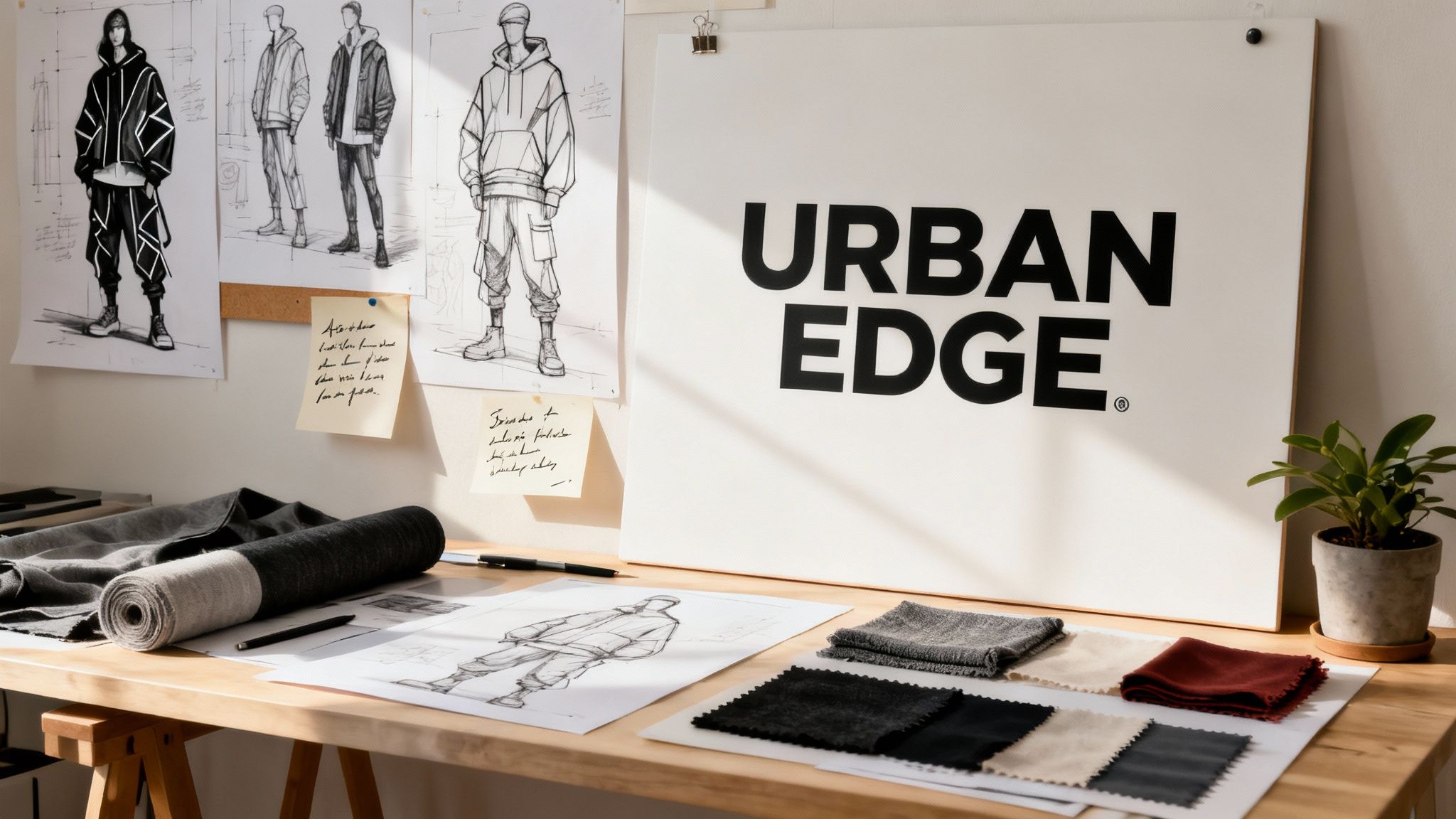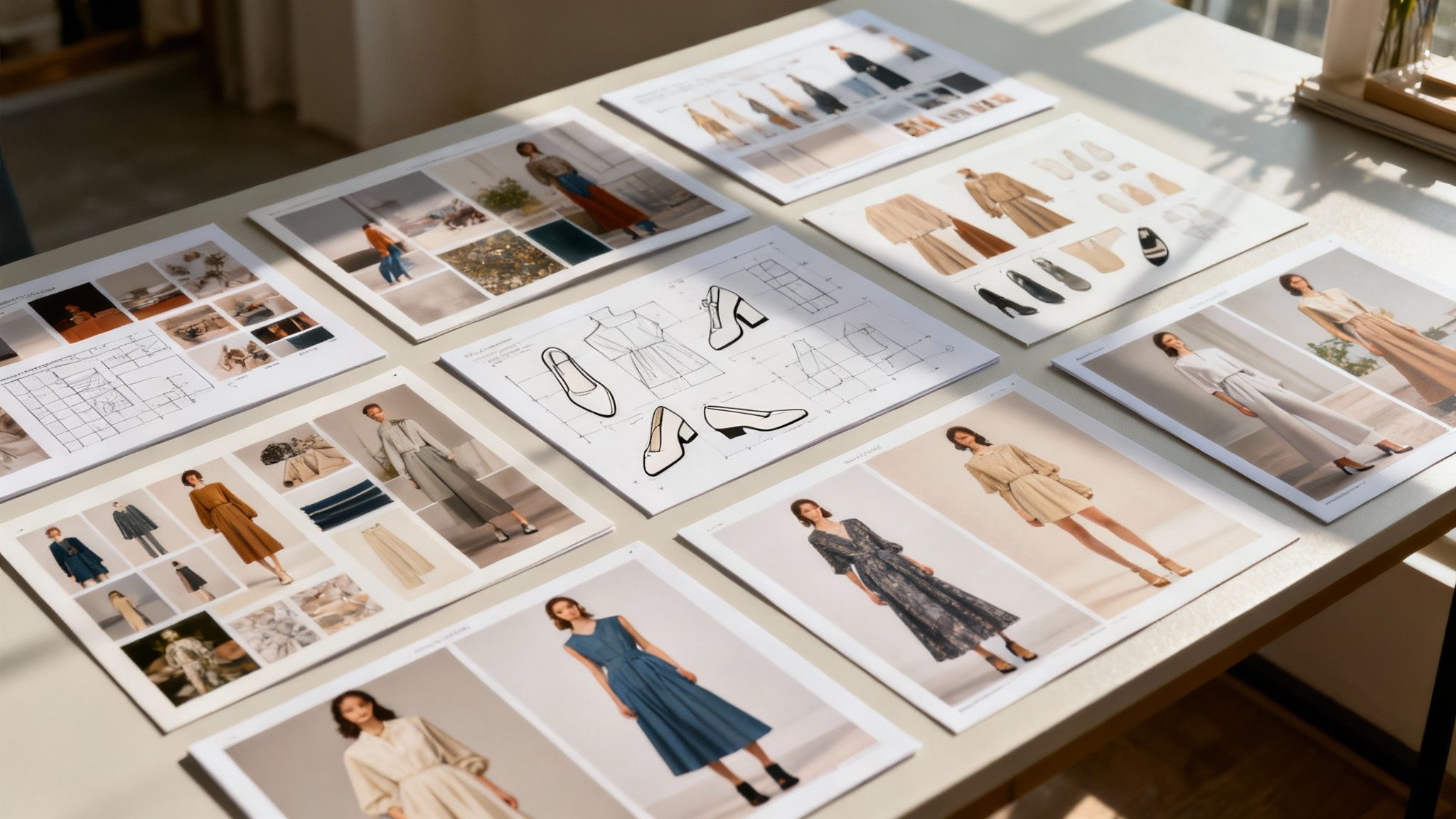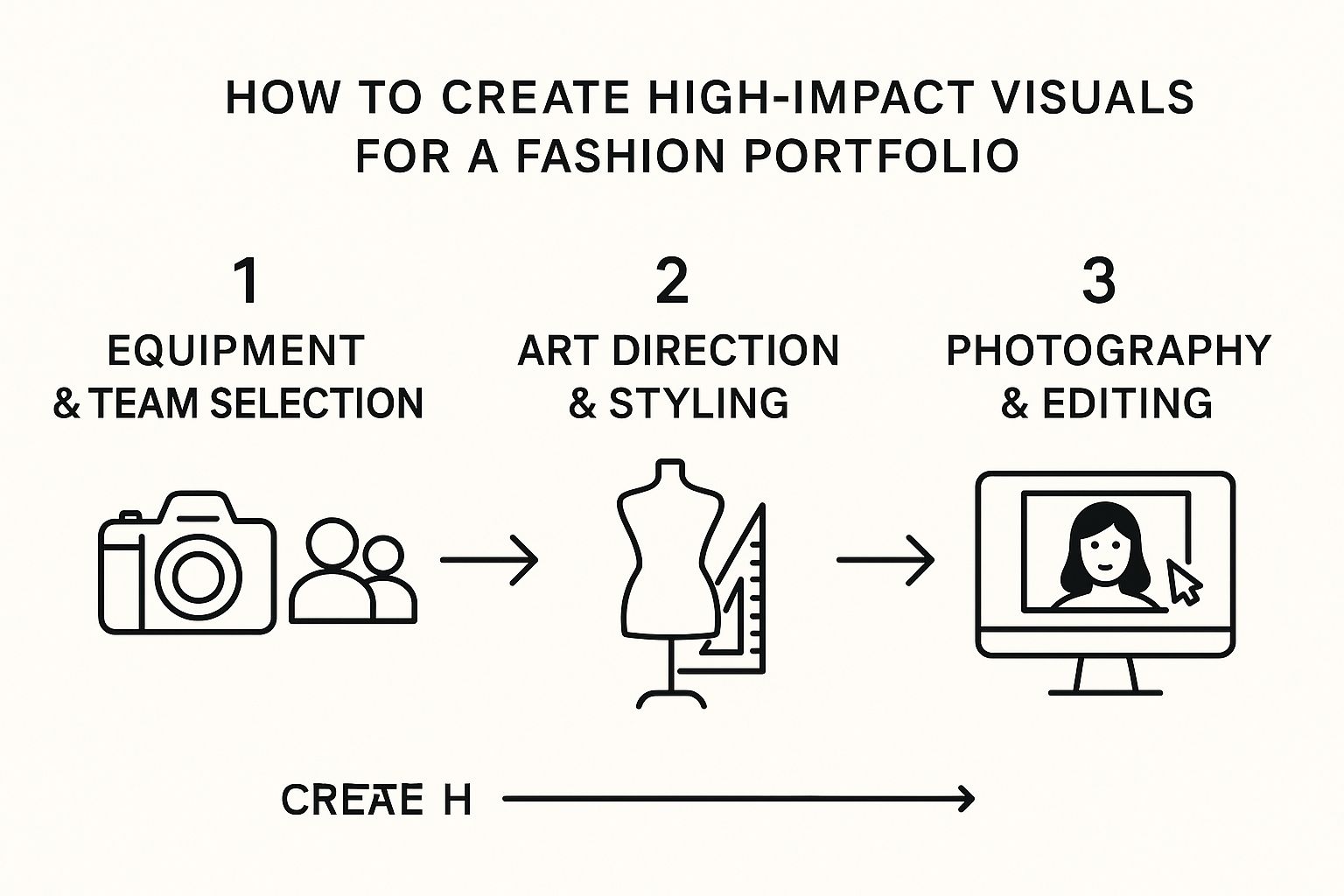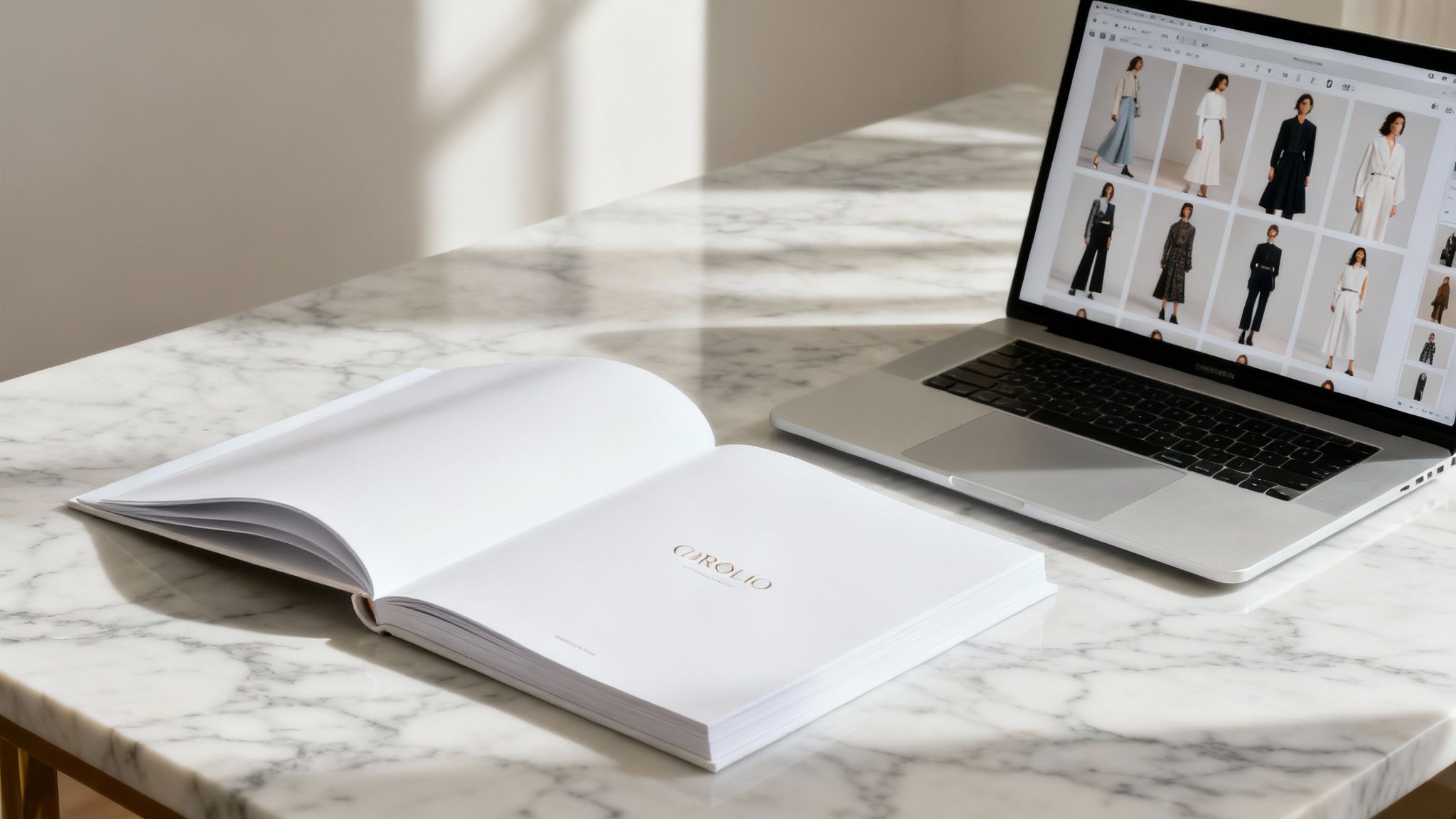
How to Build a Fashion Portfolio: Step-by-Step Guide
Learn how to build a fashion portfolio that impresses employers. Discover expert tips to showcase your style and skills effectively. Start today!
Table of Contents
Your fashion portfolio is more than just a collection of your work. It's your story. It’s the first handshake, the first impression, and the single most powerful tool you have to communicate who you are as a designer. Before you even think about which pieces to include, you have to start with the most important question: what is your unique voice?
This is where everything begins. A strong portfolio tells a cohesive story, showing not just what you can do, but what you believe in and who you're designing for. It's the visual translation of your entire creative identity.
Find Your Unique Voice as a Designer

Before you pull a single sketch or photo, you need a North Star. This is your design philosophy—a clear, guiding principle that will inform every creative decision you make from here on out. It’s what makes your work yours and sets you apart from the crowd.
So, what’s your angle? Are you all about the raw, rebellious energy of avant-garde streetwear? Or do you find your inspiration in the quiet elegance of sustainable bridal wear? Maybe your work is an exploration of gender fluidity, or perhaps it’s a celebration of traditional craftsmanship reinterpreted for a modern world. Getting clear on this helps you carve out your specific niche.
Pinpointing Your Design Niche
To get started, let’s dig a little deeper. Take some time to really think through these foundational questions. Your answers will become the backbone of your portfolio's narrative.
- Who are you designing for? Get specific. Picture your ideal customer—their lifestyle, what they value, where they hang out, what music they listen to.
- What problem does your clothing solve? Is it about incredible functionality? Unmatched comfort? Or is it a vehicle for bold self-expression?
- What do you stand for? Things like sustainability, inclusivity, and ethical production aren't just buzzwords. They can be powerful differentiators that define your brand.
This kind of clarity is critical, especially in a tough market. With only 20% of industry leaders expecting consumer sentiment to improve in 2025, you need a strong point of view. The luxury market alone is valued at around $245.5 billion, and your portfolio needs to show you understand what makes people connect with a brand on a deeper level. If you want to dive into the data, you can find more insights on the state of fashion at McKinsey.com.
Think of your design philosophy as your ultimate filter. As you start curating pieces for your portfolio, ask yourself, "Does this truly represent my core message?" If it doesn't, leave it out. It doesn't matter how technically perfect it is.
Crafting Your Brand Statement
Once you’ve got a handle on your niche, it’s time to boil it all down into a powerful brand statement. This isn't just an "About Me" paragraph; it's your mission statement. It needs to be authentic, memorable, and to the point.
For instance, a designer focused on sustainability might say: "I create modular, zero-waste garments for the conscious urban minimalist, blending Japanese pattern-making with locally sourced organic textiles." Right away, you know their niche, their values, and their unique skills.
Doing this foundational work first ensures every single piece in your portfolio serves a purpose, adding another layer to the story only you can tell. This focused approach is the secret to building a fashion portfolio that doesn't just get noticed—it gets remembered. You can also explore our guide on using AI for photography to see how new tools can help create stunning visuals that reinforce your unique brand story.
Curate a Collection of Your Strongest Work

Now that you’ve nailed down your design identity, it’s time to get tough on your own work. Think of yourself as a gallery curator, not an archivist. Your portfolio isn't a dump of everything you've ever created; it's a tight, focused story about who you are as a designer.
The aim here is to select a concise collection that screams you. I always advise designers to stick to 10-15 of their absolute best projects. This shows confidence and a sharp editorial eye—two things the industry craves. A small, killer portfolio will always beat a huge, rambling one.
The Quality Over Quantity Mindset
Every single piece in your portfolio must fight for its spot. As you go through your work, hold each project up against the brand statement you just wrote. Does it fit? Does it reinforce your unique point of view?
Let’s say you have a beautifully tailored evening gown from a past project. It’s technically perfect. But your brand statement is all about upcycled, utilitarian streetwear. That gorgeous gown, as impressive as it is, doesn't belong. Including it will only muddy your message and confuse whoever is looking at your book. You have to be ruthless.
A portfolio is a conversation. Every piece you include should be a strong talking point that reinforces who you are as a designer. If a project doesn't add to that conversation, it becomes noise.
Showcasing Your Full Creative Process
A top-tier portfolio does more than just show off a finished garment. It pulls back the curtain and reveals your creative journey. For each key project, you need to show the thinking and the work that got you from an idea to a final product. This gives recruiters a real sense of how your mind works.
A complete project presentation should feel like a mini case study. Here’s what to include:
- Initial Inspiration: Let people see where it all started. This could be a mood board, a few initial concept sketches, or photos that set the tone.
- Design Development: This is where you show the idea taking shape. Include your key fashion illustrations, fabric swatches, and color palettes to walk them through your decision-making.
- Technical Skills: Prove you can bring your vision to life. This means showing clean, professional technical flats—those detailed 2D drawings that map out every seam, stitch, and construction detail.
- The Final Product: The grand finale. High-quality, professionally shot photos of the finished garment are non-negotiable. This is the payoff.
This approach turns your portfolio from a simple lookbook into a powerful story about your skills. It’s your professional pitch deck. It’s similar to how influencers use media kits to package their brand story. For inspiration, check out these influencer media kit examples to see how pros sell their value.
By curating a collection that shows both your beautiful final pieces and the smart process behind them, you create a portfolio that doesn’t just look good—it proves your talent from start to finish.
Create Visuals That Make Your Designs Shine
Your designs might be brilliant, but in a portfolio, they're only as good as the pictures you take of them. It's a tough truth. Professional, high-impact photography isn't just a bonus—it's what makes a great design stick in someone's mind and truly tells the story behind your work.
Pulling off great visuals starts way before anyone picks up a camera. It’s all about getting the right creative team on board. Even if you're working with a tiny budget, you can find people who are just as passionate as you are. Think about reaching out to photography students, local models looking to build their portfolios, or stylists eager for a cool project. These collaborations are your ticket to getting stunning shots without breaking the bank.
Mastering Art Direction
You are the art director here. It's your vision, and it’s your job to make sure every single photo reflects the story you want to tell. Before you even think about shoot day, put together a detailed mood board. This is how you'll communicate the exact lighting, poses, and overall vibe you’re going for. Do you want something soft and romantic with natural light, or are you aiming for edgy and high-contrast?
A successful photoshoot is 10% photography and 90% preparation. Your ability to communicate a clear vision to your team will make or break your final images. Don’t be shy—take charge and guide the process.
This planning phase, from team selection to art direction, is what leads to those truly exceptional final shots.

As you can see, what happens after the shoot is just as important. Post-production is where you turn good photos into portfolio-grade assets.
Photographing Your Process
Don’t forget to show the work that happens before the final piece. Your illustrations, technical drawings, and fabric swatches are all part of the story, and they deserve to be photographed with just as much care.
Here’s a simple checklist to get this right.
Portfolio Visuals Checklist
This checklist will help you make sure every visual element, from your sketches to your final garments, is captured professionally.
| Visual Element | Key Objective | Pro Tip |
|---|---|---|
| Illustrations/Sketches | Capture artistic detail and color without glare or shadows. | Shoot in bright, indirect natural light. Tape the corners to a white foam board to keep it perfectly flat. |
| Technical Flats | Show clean, precise lines and construction details clearly. | Use a high-resolution scanner if possible. If not, shoot directly from above to avoid any angle distortion. |
| Fabric Swatches | Showcase texture, drape, and true-to-life color. | Get up close. Use a macro lens setting if you have one, and make sure your lighting highlights the fabric's texture. |
| Garment on Model | Demonstrate fit, movement, and the design's overall mood. | Plan your poses in advance. Capture the garment from multiple angles—front, back, and a detail shot. |
| Garment on Mannequin | Display the garment's structure and form without distraction. | Use a neutral, seamless background. Steam the garment meticulously to remove every single wrinkle. |
Paying attention to these details ensures every part of your creative process looks as polished as your final work.
The final touch is in post-production. Small tweaks to brightness, contrast, and white balance can elevate your process shots from "good" to "great." For a deeper dive, check out our guide on color correction for photos for some practical tips. This is that last step that makes sure your portfolio looks absolutely seamless.
Choose the Right Portfolio Format

You’ve curated your best work—now, how are you going to show it off? The presentation is just as critical as the designs themselves. In fashion, you need to be prepared to shine in two very different arenas: the classic, in-person interview and the non-stop digital world.
Think of it this way: a physical portfolio is your ace for face-to-face meetings, while a digital portfolio is your 24/7 global ambassador. Mastering both is non-negotiable for a serious designer.
The Power of the Physical Portfolio
Never, ever underestimate the impact of a physical portfolio. When you walk into an interview and place a beautifully crafted book on the table, it makes a statement. It has a weight and texture that a screen simply can't match, creating a focused, tactile experience.
It shows you’ve invested real time and effort. Here's what to focus on when putting your book together:
- Binding and Cover: Go for a clean, professional binder or get it custom-bound. Materials like leather or high-quality linen in a neutral tone always look sophisticated.
- Paper Quality: This is huge. Use heavyweight, archival-quality paper with a matte or satin finish. It feels substantial and cuts down on distracting glare.
- Layout Flow: Tell a story. Lead with your most jaw-dropping collection to hook them instantly, then end with another powerhouse project to leave a memorable final impression.
A physical book allows a hiring manager to connect with your work without the constant pings and open tabs of a computer. It’s an intimate, focused moment—make it count.
Mastering Your Digital Presence
Your digital portfolio is your single most important marketing tool. It has to be sharp, easy to navigate, and easy for people to find. This is where you prove you’re plugged into the modern industry.
The global fashion market is massive, projected to be worth around $1.84 trillion by 2025. Your online presence needs to prove you can capture an audience in a world where fashion eCommerce is set to top $905 billion. To get a better sense of the numbers, check out how the global apparel industry's growth impacts designers on uniformmarket.com.
So, where should you actually build this thing? You have a few solid options:
- Personal Website: This gives you maximum brand control. Platforms like Squarespace or Wix have gorgeous, user-friendly templates that are perfect for a visual portfolio.
- Portfolio Platforms: Sites like Behance and Adobe Portfolio are fantastic for getting your work seen by the wider creative community. They’re simple to use and put you in front of a built-in audience.
- Professional Networks: Don't sleep on LinkedIn! It’s more than just a resume hub. You can build out project sections that function as a mini-portfolio, putting your work directly in front of recruiters. Our guide on how to optimize your LinkedIn profile has some great tips for this.
Your digital portfolio is a living document. Unlike a printed book, you can and should update it regularly with new projects, press, and evolving skills. Keep it fresh to show you’re active and constantly growing as a designer.
Show You're Plugged into the Industry
A great portfolio does more than just show off your designs—it proves you’re a forward-thinking professional who gets the bigger picture. It shows you’re paying close attention to the conversations and shifts happening in fashion right now. You're not just designing for today; you're thinking about tomorrow.
This means you need to be intentional about weaving these major industry themes into your work. Don't just show a beautiful garment; explain the "why" behind it. If you chose a recycled textile or a low-impact dye, make sure you call that out. That context is everything.
Weave Sustainability into Your Story
Let's be clear: sustainability isn't a niche trend anymore. It's a fundamental expectation. Hiring managers and creative directors are actively looking for designers who can create with a conscience. Your portfolio is your prime opportunity to prove you're one of them.
Here are a few practical ways to do this:
- Spotlight Your Materials: Dedicate a section or a page to your fabric choices. Show swatches of organic cotton, Tencel, or even more innovative materials like pineapple leather. More importantly, explain why you chose them.
- Show Off Circular Design: Did you design a garment for easy disassembly? Or use a zero-waste pattern? Make that a central point of the project. You could even include an image of the pattern layout to prove your technical skill and sustainable mindset.
- Feature an Upcycling Project: Nothing tells a story of resourcefulness like a collection that gives old materials new life. Document the "before" and "after" to create a powerful narrative.
The backlash against fast fashion—an industry projected to reach $291.1 billion by 2032—is driving a massive shift toward conscious consumerism. When you show you can design solutions, not just more clothes, you prove you're in tune with this reality. You can learn more about the fast fashion market at uniformmarket.com to get a sense of just how big this conversation is.
Your portfolio needs to answer the silent questions every recruiter is asking: "Does this person understand our customer's values? Can they innovate responsibly?" A project focused on sustainability screams a confident 'yes' to both.
Prove Your Market and Tech Smarts
Beyond sustainability, your portfolio should signal that you understand market trends and the tech that's reshaping fashion. Your work doesn't exist in a bubble, and you need to show you get that.
This is your chance to demonstrate you're thinking about the business side of creativity. For instance, if you've designed a collection, who is it for? Pop in a quick customer persona or a brief market analysis. It shows you're not just an artist, but a strategic thinker.
Likewise, integrating technology shows you’re ready for what’s next. You absolutely should mention your skills with digital pattern-making software or 3D design programs. You could even include a conceptual project that explores future-facing ideas. Our guide on virtual try-on technology is a great starting point for understanding how new tools are changing retail. This kind of forward-thinking makes you a much more compelling hire for any modern brand.
Your Top Portfolio Questions, Answered
As you start pulling your fashion portfolio together, a few common questions always seem to pop up. It doesn't matter if you're fresh out of design school or a seasoned pro looking for a change—these little uncertainties can feel like big hurdles. Let's get them sorted out.
So, how many pieces should you actually show? This is probably the number one question I get. My advice is always the same: quality over quantity.
Aim for 10 to 15 of your absolute best projects. That’s the sweet spot. It's enough to show your range and skill, but not so much that you overwhelm the person reviewing it. A portfolio with 12 amazing, well-thought-out pieces will always beat one with 30 okay-ish ones. Always.
What about student work? Or that passion project you did on the side? Yes, include it! But only if it’s genuinely your best work and reflects the designer you are today. That brilliant collection from your final year that truly captures your unique point of view? It absolutely deserves a place in your book.
Tackling Tricky Portfolio Situations
Showing work you did as part of a team can feel complicated, but it doesn't have to be. The key is to be completely honest about your role. Great collaborative projects belong in your portfolio, but you have to be specific about what you did.
- For Group Projects: A simple, clear caption is all you need. For example: “I was responsible for the initial concept, all pattern-making, and the final construction of this garment.”
- For Professional Work: If you were part of a team at a larger company, you could say something like, “Contributed to the womenswear knit collection at [Brand Name], where I focused on sourcing yarn and creating technical flats.”
Being upfront builds trust. It also shows you’re a great team player, which is a massive asset in this industry.
Your portfolio is a reflection of your skills and your character. Being honest about collaboration doesn’t weaken your presentation—it makes you look more professional and credible.
Making the Most of What You've Got
Okay, what if you have a fantastic design, but the photos are… not so fantastic? It’s a common and frustrating problem. If the pictures are really letting the design down, you've got a couple of choices. You could try reshooting it—you don't need a massive studio; sometimes, a clean backdrop and good natural light are enough.
If a reshoot isn't an option, then lean into your process.
Show off the beautiful illustrations, the detailed technical flats, and the fabric swatches that brought the piece to life. When you highlight the incredible work that went into the design, you can still tell a powerful story, even if the final photo isn't perfect. It's all about making sure every single project in your book is working hard for you.
Ready to create stunning, professional-quality visuals for your portfolio without the hassle of a traditional photoshoot? With YourAIPhotographer, you can generate photorealistic images of your designs, create polished headshots, and build an entire visual brand from your laptop. Explore the possibilities at youraiphotographer.com and start creating images that get you noticed.
